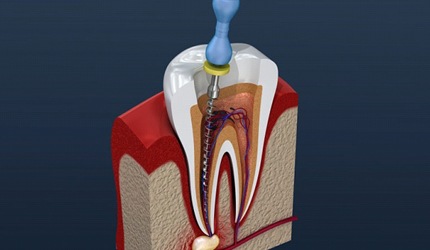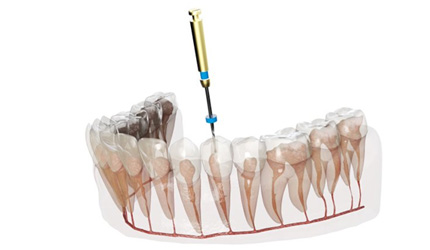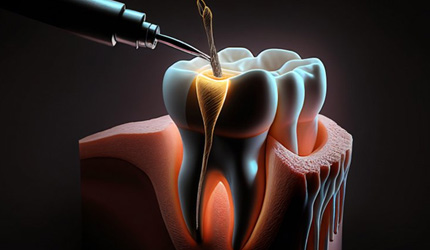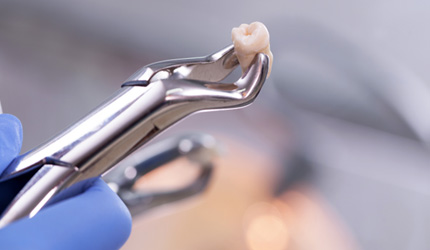Root Canal Therapy – DeSoto, TX
We Can Save Your Damaged Tooth!
When people hear the phrase “root canal therapy,” they tend to tense up at first. But many people don’t realize that root canals are not designed to cause discomfort or make your life more difficult. The fact is root canal therapy takes you out of pain, instead of causing it. This common misconception prevents many people from getting the treatment they need. If your tooth is in pain, Dr. Suzanne Najjar can safely and effectively remove decay and restore your tooth’s functions to the fullest. Call our dental office to schedule an appointment for root canal therapy in DeSoto today!
Why Choose Amaze Dental for Root Canal Therapy?
- Nitrous Oxide and Oral Conscious Sedation Available
- Soft Tissue Laser for Greater Ease and Comfort
- Computer-Assisted Local Anesthesia Available via The Wand™
What Is a Root Canal?

A root canal is a treatment during which the center portion of the tooth, known as the pulp, is extracted. It’s a necessary procedure to save a severely damaged tooth from needing to be extracted. Although root canal therapy is one of the most common restorative dental procedures, it’s usually used as a last resort to save a tooth.
More often than not, your tooth will need to be fitted with a dental crown after your root canal. A crown is a custom-made “cap” that is bonded to a tooth to protect it from future damage. Since your tooth will be vulnerable after root canal therapy, it never hurts to add a little extra protection.
Do I Need a Root Canal?

One of the most common signs that you need a root canal is moderate to severe discomfort in your tooth. However, that’s not the only symptom to keep in mind. Dr. Najjar, your dentist in DeSoto, will confirm if a root canal is necessary during your detailed exam, but if you experience any of the following symptoms, get to our dental office as soon as possible:
- Facial swelling
- Pimple-like bumps on gum tissue
- Darkening of the tooth (gray, brown or black in color)
- Fever
- Extreme sensitivity to hot or cold temperatures
What Can I Expect During a Root Canal?

To begin your procedure, we numb your mouth with a powerful local anesthetic, and possibly even sedation, to ensure your comfort. We then create a small hole in your tooth, through which we extract the damaged pulp along with the nerve. After we clean the inside of the tooth, we replace the inner portions with a synthetic material called gutta-percha. Once the tooth is sealed back up, we take an impression, which we then use to design your dental crown. Until it’s ready, we can place a temporary crown to protect your tooth in the meantime.
What Are the Benefits of Root Canal Therapy?

Are you in severe dental pain? Schedule an appointment with us so we can determine whether root canal therapy is just the treatment your smile needs.
Understanding the Cost of Root Canals

How much does a root canal cost? The cost of your root canal will be different than what someone else will pay for their procedure. Although it might seem unreasonable for there to be different prices for this type of treatment, the reason the cost varies is that each case is unique. The factors our team considers during your scheduled consultation will determine what kind of out-of-pocket expenses will be necessary to save your tooth from extraction.
Factors That Can Affect Root Canal Cost

During your scheduled consultation with our team at Amaze Dental, our dentists will use the following factors to identify the severity of your existing tooth damage and what kind of cost can be expected:
- Where the damaged tooth is located inside your mouth (back teeth tend to be more difficult to treat than those located toward the front of the mouth)
- The type of tooth that requires treatment
- The severity of the damage or decay that needs to be addressed and if a specialist needs to be brought in to complete the work
- Whether you require additional services, such as a dental crown that is likely required to protect the newly treated tooth
Is It Cheaper to Pull My Tooth?

Tooth extraction is often a suggestion that many patients bring up during a consultation; however, the reason our team does not recommend this approach is for several reasons:
- It’s always better to keep your natural teeth as long as possible
- There is a significant cost associated with tooth replacement, no matter if you receive a dental bridge, partial denture, or dental implant
- The maintenance required with tooth replacement can cause costs to add up over time
- If you have a tooth extracted and do not replace it immediately, you could suffer bone and additional tooth loss, which will cost more to treat
Opting for a root canal means you get to keep your natural tooth and avoid the long-term expense that is often required with tooth replacement. Not to mention, root canal treatment is highly successful.
Does Dental Insurance Cover Root Canals?

Most dental insurance companies will provide partial coverage for root canals; however, you should plan to review your policy or ask a member of our team before agreeing to start treatment. The average percentage of coverage can range from 50-80% in most cases, but whether you’ve met your deductible and how much of your existing annual maximum remains are two factors your insurance company will consider before paying their portion.
Other Options for Making Root Canal Therapy Affordable

At Amaze Dental, we are pleased to partner with CareCredit Financing to make paying for a root canal more affordable. Instead of being forced to pay out of pocket for the entire price of your procedure upfront, you can enroll in a plan that offers low- or no-interest so that you can pay down the total balance over time. It works similarly to a credit card, allowing you to focus on caring for your smile as opposed to putting off treatment because you cannot afford it.
Root Canal FAQs
Is root canal therapy safe?
Not only is root canal therapy a perfectly safe treatment to complete, but it’s performed by dentists and endodontists millions of times every single year. It’s the most effective treatment for resolving severe dental infections that put teeth at risk of needing an extraction. As long as you take proper care of the treated tooth going forward, your tooth should last for many years without concern.
What should I expect after treatment?
Just like with any significant dental treatment, you can expect your tooth to feel a little sensitive for the next few days. This feeling should go away after a day or so and can be managed with over-the-counter painkillers. However, you will need to avoid chewing tough foods on that side of your mouth until the permanent restoration is placed. At your follow-up appointment, we’ll discuss how to take care of your treated tooth, ensure the infection is gone, and confirm the area is healing properly.
How should I take care of my tooth moving forward?
The best way to reduce your risk of your treated tooth from becoming damaged further is to practice consistent at-home oral care. This includes brushing twice a day with a fluoridated toothpaste as well as flossing at least once a day to remove plaque from the sides of teeth. It’s recommended that you visit our office once every six months so we can examine not just the condition of your oral health, but the tooth that received root canal therapy.
How long does root canal therapy take?
In most cases, root canal therapy should only take about an hour to complete. Alternatively, situations where multiple root canals need to be completed can increase the length of treatment to as long as two hours. However, our office will take as much time as we need to ensure all of the damaged portions of the pulp are removed so the infection does not come back.
Will root canal therapy weaken my tooth?
While it is true that removing inner sections of the tooth will weaken its overall structure, we take the necessary steps to ensure it remains durable and lasting for years to come. This includes placing a dedicated restoration on top of the treated tooth. The alternative is your tooth continues to break down and require extraction anyway, which is why it’s best to complete a treatment that works to save the root portion and reinforce the crown, rather than take out the tooth entirely.
Can I Eat Before a Root Canal?
If you are being sedated for your root canal, then we may ask you to fast leading up to the procedure to prevent you from feeling nauseous. If you aren’t being sedated, then you can eat prior. Just make sure that it’s a healthy, well-balanced meal and that you brush your teeth afterward.
What Happens if You Wait Too Long for a Root Canal?
Oftentimes, patients who struggle with dental-related anxiety are tempted to take the “wait and see” approach. While that may seem harmless, the more time that passes, the worse the root of the problem will get. So, it’s of the utmost importance that you get a root canal when we first recommend one. If you don’t, then there may come a time when the tooth can no longer be saved, requiring us to extract it instead.
Can Root Canals Be Prevented?
Oftentimes, yes! That’s why our DeSoto dental team recommends incorporating healthy habits into your routine – from brushing twice a day to wearing a mouthguard during sports and cutting back on added sugar. Although habits like these may seem insignificant, they play a big role in protecting your teeth from harm.
Are Root Canals Painful?
One of the biggest misconceptions about root canals in DeSoto is that they are painful. That’s not the case! Not only are the latest dental techniques and technology used, but your mouth is thoroughly numbed beforehand. Plus, you’ll be given a set of aftercare instructions to help you heal comfortably as well. In short, we go the extra mile to ensure that eliminating the infection and restoring your healthy smile is painless instead of painful.
Do Root Canals Make You Sick?
The belief that root canals lead to illness stems from a study conducted back in the 1920s. At the time, a man named Dr. Weston Price claimed that it was better to remove the tooth since root canal treatment didn’t remove all of the bacteria. However, his research was poorly designed, and his theory has been debunked for several decades now. Today, there isn’t any scientific evidence supporting the claim that root canals can make you sick.
Why Do I Need a Root Canal if My Tooth Doesn’t Hurt?
It’s true; dental damage is often accompanied by persistent sensitivity, pain when biting down, or dull, throbbing discomfort. However, those aren’t the only warning signs of trouble. During your routine checkups, we also look for dark discoloration, a pimple-like bump on your gums, a hole in your tooth, and other indicators that root canal treatment is necessary.
Important note: If you have any questions about our treatment recommendations or what we found during your exam, don’t hesitate to ask! We want you to be involved, especially when it comes to something as important as your oral health.